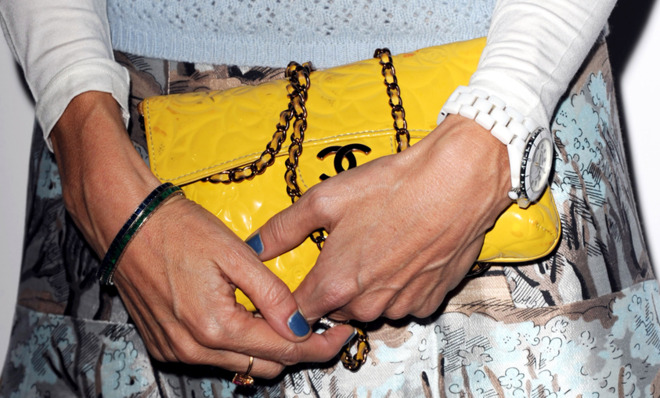7 obscure status symbols
In some parts of the world, people would rather have a pile of powdered rhino horn than a Lexus


The expensive SUV, the family vacation that requires a passport, and the causal assertion that you never (have to) shop at Walmart — these are all familiar American status symbols, showing the difference between the people who thrive and those who merely survive. But every culture and sub-culture has a hierarchy, and ways to show your place in it. Here we look at the different ways people let their status show.
1. No logo
If your purse or sunglasses have the designer's logo on them — even an expensive one — you're clearly not part of the in-crowd. A new study published in The Journal of Consumer Research suggests that the more expensive the product, the more anonymous it is. People who can afford a $19,000 purse apparently don't need a signature to recognize valuable accessories.
The Week
Escape your echo chamber. Get the facts behind the news, plus analysis from multiple perspectives.

Sign up for The Week's Free Newsletters
From our morning news briefing to a weekly Good News Newsletter, get the best of The Week delivered directly to your inbox.
From our morning news briefing to a weekly Good News Newsletter, get the best of The Week delivered directly to your inbox.
2. A little sunshine
According to the book Mind Your Manners: Managing Business Cultures in the New Global Europe by John Mole, the Western business world is never-ending Casual Friday — at least by Japan's standards. Japanese office culture demands that a worker never transgress his status or infringe on anyone else's status. And as you might expect from a society as polite and self-deprecating as Japan's, those differences in status are expressed very subtly. Senior workers may speak and dress the same as every other worker, but their desks are turned to the windows, allowing them to escape the never-ending presence of fluorescent lighting. Also, business cards are a good indicator, with lower-level employees declining to purchase cards too fancy for their pay grade. In a society where it is rude to stand out, status can only be found in the tiniest of details.
3. Stickers
Europe has long used black and white letter codes to identify which country a car is from, much in the same way we use license plates to recognize different states. The stickers have been co-opted by the some of the most elite communities in the U.S., and only those who belong are meant to recognize them. EH for East Hampton, SGH for Sag Harbor, BH for Bridgehampton, and so forth. In an article in The New York Times, most people who displayed the elite codes on their bumpers claimed indifference or ignorance — anything but snobbishness. Richard Smith, a social psychologist at the University of Kentucky, says that the stickers are status symbols, and that their owners know it. "People don't put stickers on their bumpers to make themselves look worse," he points out.
A free daily email with the biggest news stories of the day – and the best features from TheWeek.com
4. Rhino horn
A wealthy American might invite a guest to partake of an illicit Cuban cigar. An important Vietnamese, on the other hand, might offer up a bit of powdered rhino horn. Both show that the man in question has the connections and wealth to skirt the law and obtain desirable products. A study conducted in Vietnam found that 720 people in Hanoi and Ho Chi Minh City admitted to owning rhino horn — and that many of those who didn't intended to acquire it someday. While having a stash supposedly offers "peace of mind," 668 rhinos were illegally poached in South Africa in 2012 to help support this fashion.
5. Fat girls
At times in Western history when food was scarce, fat was beautiful; a physical representation of good food and little labor. Today, in parts of the world that still struggle to sustain themselves, fat is still the fashion. In the North African country of Mauritania, little girls are sent to "fat farms" where they put on the pounds. The women who manage these eating camps promise to return a girl to her parents chubby enough to attract the highest quality of husband. The Mauritanian government frowns on the practice, citing the health concerns stemming from obesity.
6. Oscar screeners
For the film lover, nothing shows your connections to the Hollywood scene like a screener. Screeners are copies of potential Oscar-winning films sent by studios to specific members of the Academy of Motion Picture Arts and Sciences. They are quite official and never meant to leave the possession of the voting member, but that doesn't stop their eventual circulation in the pirated community. Read more here.
7. Midwives
Years ago when I suggested to my husband that I might like our first child to be delivered by midwife, he responded, "Super! That way if there are life-threatening complications you'll have someone to chant and wave burning sage over your stomach." But the perception of midwives as unskilled holdovers from the Middle Ages has rapidly changed in the past decade. Now, the woman who procures the services of a midwife is a woman who is on top of things. The midwife is often the beginning of an enriching — and expensive — life of organic and natural choices the mother plans for her child. There are now high-end midwife boutiques in all large cities, most with more applicants than they can attend to. Scarcity increases value, which means midwife-attended births have become an indicator of high status.
Therese O'Neill lives in Oregon and writes for The Atlantic, Mental Floss, Jezebel, and more. She is the author of New York Times bestseller Unmentionable: The Victorian Ladies Guide to Sex, Marriage and Manners. Meet her at writerthereseoneill.com.
-
 US citizens are carrying passports amid ICE fears
US citizens are carrying passports amid ICE fearsThe Explainer ‘You do what you have to do to avoid problems,’ one person told The Guardian
-
 All roads to Ukraine-Russia peace run through Donetsk
All roads to Ukraine-Russia peace run through DonetskIN THE SPOTLIGHT Volodymyr Zelenskyy is floating a major concession on one of the thorniest issues in the complex negotiations between Ukraine and Russia
-
 Why is Trump killing off clean energy?
Why is Trump killing off clean energy?Today's Big Question The president halts offshore wind farm construction
